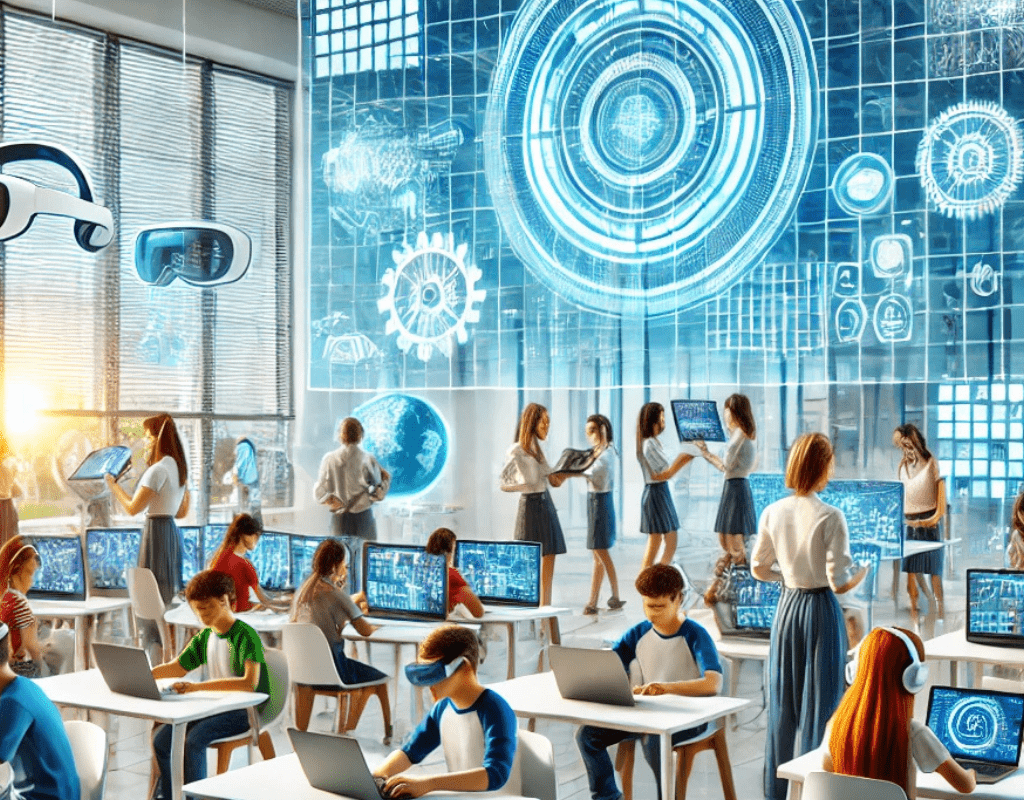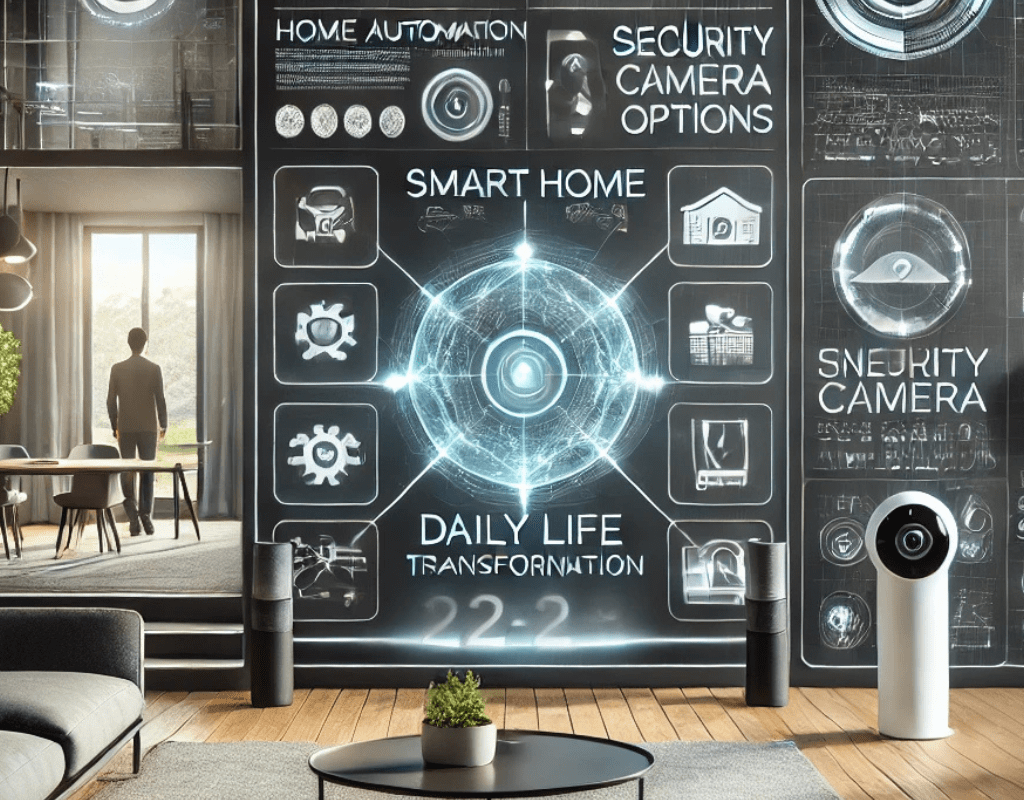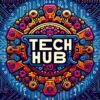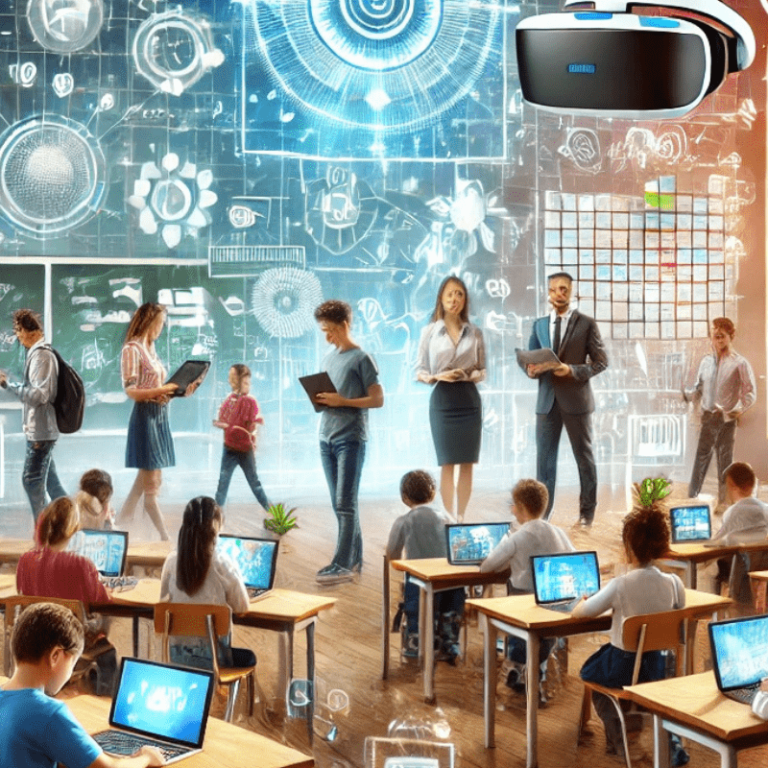Introduction
The educational landscape is undergoing a significant transformation, driven by the rapid advancement of technology. From traditional chalkboards to smart classrooms, the integration of innovative technologies in education is revolutionizing how students learn and educators teach. This shift is not just about keeping up with technological trends; it’s about preparing students for a future where digital literacy and adaptability are crucial. This blog post explores the top 8 technologies that are redefining the future of education, highlighting their impact and potential.
Table of Contents
Artificial Intelligence in Education
Artificial Intelligence (AI) is no longer just a futuristic concept; it’s an integral part of modern educational technologies. AI-powered tools offer personalized learning experiences by analyzing student data and adapting lessons to meet individual needs. This level of customization is one of the key technologies enhancing student engagement and understanding. For instance, Squirrel AI Learning in China has demonstrated significant improvements in student performance by leveraging AI to tailor learning paths. AI also plays a role in assessing student performance, providing educators with insights into areas where students may need additional support. Tools like adaptive learning platforms and chatbots are becoming commonplace technologies, offering students instant feedback and assistance.
Virtual Reality and Augmented Reality

Virtual Reality (VR) and Augmented Reality (AR) are creating immersive learning experiences that were once unimaginable. These technologies enable students to explore new worlds and concepts interactively. Imagine learning about ancient civilizations by virtually walking through historical sites or understanding complex scientific processes through 3D simulations. The University of Glasgow’s use of VR for teaching surgical skills is a prime example, resulting in better knowledge retention and understanding. VR and AR enhance engagement and retention while providing a safe environment for practical training, making them invaluable educational tools.
Learning Management Systems (LMS)
Learning Management Systems (LMS) have become essential in modern education, providing a centralized platform for course management and communication. LMS platforms offer features such as course creation, analytics, and student-teacher interaction, making them indispensable for distance learning. They facilitate easy access to resources and encourage collaboration among students. By streamlining the educational process, LMS platforms promote a more organized and efficient learning environment, ultimately enhancing the educational experience for both students and educators.
Gamification in Education
Gamification applies game design principles to educational contexts, increasing motivation and engagement. By incorporating elements like points, badges, and leaderboards, gamification encourages healthy competition and provides instant feedback to learners. Educational games and platforms, such as Duolingo, have successfully used gamification to make learning languages more engaging. This approach not only motivates students but also helps them retain information more effectively, transforming learning into an enjoyable and rewarding experience.
Cloud Computing
Cloud computing is revolutionizing education by providing scalable and flexible solutions for collaboration and storage. Cloud-based tools enable real-time collaboration on projects, allowing students and educators to work together seamlessly. This technology reduces the need for physical resources, making education more accessible and cost-effective. Cloud computing also facilitates remote learning, ensuring that students can continue their education regardless of their location, thereby bridging the gap between traditional and modern learning environments.
Mobile Learning (mLearning)
Mobile learning, or mLearning, leverages mobile technologies to deliver educational content, offering unparalleled accessibility and flexibility. Through the use of innovative technologies, students can learn on-the-go, adapting their studies to fit their busy lifestyles. A variety of apps and platforms enhance mLearning by providing multimedia resources that cater to diverse learning styles, demonstrating how technologies can ensure students have access to educational content anytime, anywhere, thus promoting continuous learning and knowledge retention.
Big Data and Learning Analytics
Big data and learning analytics are transforming education by providing valuable insights into student performance and behavior. By analyzing large datasets, educators can make informed decisions to improve teaching strategies and student outcomes. Tools for learning analytics identify patterns and trends, allowing for early intervention and support for at-risk students. This data-driven approach not only enhances the educational experience but also empowers educators to tailor their teaching methods to better meet the needs of their students.
Blockchain in Education
Blockchain technology, known for its secure and transparent nature, is finding applications in education. It offers a decentralized and tamper-proof system for credential verification and record-keeping, enhancing trust and transparency. Blockchain streamlines administrative processes, making it easier for institutions to manage student records and credentials. For students, this technology ensures that their academic achievements are securely documented and easily verifiable, offering peace of mind and facilitating seamless transitions between educational and professional environments.
Embracing Change in Educational Practices
As the landscape of education continues to evolve with technological advancements, educators, students, and institutions must adopt a proactive approach to embrace change. This involves not only the integration of new technologies but also a shift in pedagogical strategies to optimize learning outcomes. Professional development and ongoing training for educators become essential to help them adapt to new tools and methodologies. Inclusive education practices can further ensure that technology benefits every learner, tailoring to individual needs and diversifying teaching methods. By fostering a culture of innovation and flexibility, the education sector can navigate these changes effectively, ensuring that learners are equipped with the critical skills and knowledge they need in an increasingly complex world.
The Future of Virtual Reality in Education
Virtual Reality (VR) holds the promise of revolutionizing educational experiences by providing immersive, interactive environments that enhance learning engagement and comprehension. By simulating real-world scenarios, VR allows students to explore and interact with complex subjects in a controlled yet stimulating setting. Whether it’s participating in a virtual field trip to ancient civilizations or conducting chemistry experiments in a virtual lab, the experiential learning opportunities are vast. VR also supports diverse learning needs, offering alternative approaches that can make understanding difficult concepts more accessible.
The Impact of Augmented Reality in Education
Augmented Reality (AR) is another groundbreaking technology reshaping the educational landscape by overlaying digital elements onto the real world. This technology enhances classroom learning by providing interactive and visually engaging content that can bring subjects to life. For example, AR can transform a traditional biology lesson into an exploration of the human body, allowing students to visualize and interact with 3D models of organs and systems. This hands-on approach to learning not only aids in better understanding but also retains the interest and curiosity of students. AR apps and tools offer educators innovative ways to present information, accommodate diverse learning styles, and make complex topics more approachable. As AR technology continues to evolve and become more accessible.
Integrating Blockchain Technology in Education
Blockchain technology is increasingly being recognized for its potential to transform the educational landscape. This technology offers a secure and transparent way to verify academic credentials, greatly reducing the potential for fraud. By utilizing blockchain technology, institutions can store educational records in an immutable and easily accessible ledger, ensuring that student achievements are accurately documented and shared. Additionally, blockchain technology enhances data security and privacy, which are critical concerns in the digital age. This technology empowers students by giving them control over their personal academic records, facilitating smoother transitions between educational institutions and employment opportunities. As the adoption of blockchain technology in education continues to expand.
Challenges of Digital Transformation in Education
Despite the numerous advantages technology brings to education, the digital transformation also presents significant challenges. One primary concern is the digital divide that persists among communities, resulting in unequal access to technology and the internet. Additionally, educators face the task of acquiring new skills to effectively integrate digital tools into their teaching strategies. Addressing data privacy and security issues while incorporating new technologies is also crucial to provide safe and equitable learning experiences for all students.
Gamification in Education
Gamification introduces game elements into educational settings, leveraging technologies to foster increased student engagement and motivation. By incorporating rewards, challenges, and interactive scenarios, these technologies make learning more enjoyable and dynamic. This approach combines innovative technologies with traditional methods to stimulate critical thinking and problem-solving skills, enhancing the overall educational experience and encouraging active participation in the learning process.

Conclusion
The integration of innovative technologies in education is not just a trend; it’s a necessity for preparing students for the future. These technologies hold the potential to create a more engaging, efficient, and inclusive learning environment. Educators and institutions must embrace these changes to ensure that they are providing students with the skills and knowledge they need to succeed. By harnessing the power of technology, we can pave the way for a brighter future in education, where every student has the opportunity to reach their full potential.
Share your thoughts below on how you envision these technologies shaping the future of learning and join the conversation about the exciting possibilities they hold
“Get in touch with us for inquiries or collaborations on our Contact Page at TechHubComing.com!”




